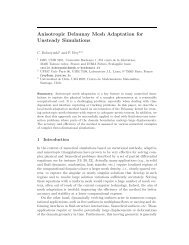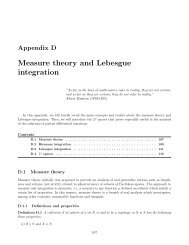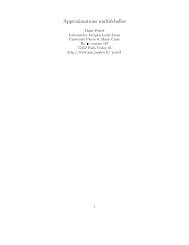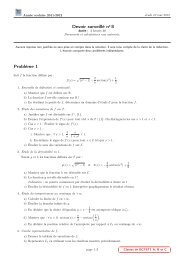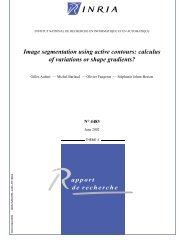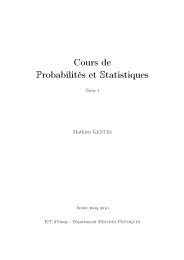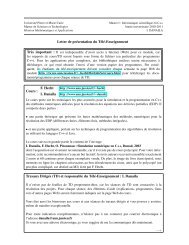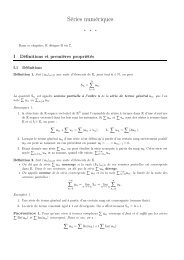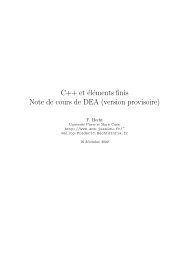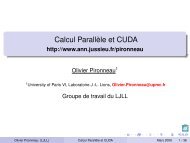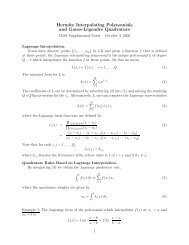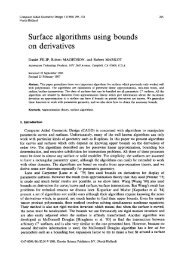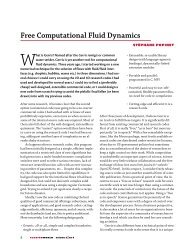Couples de variables aléatoires
Couples de variables aléatoires
Couples de variables aléatoires
You also want an ePaper? Increase the reach of your titles
YUMPU automatically turns print PDFs into web optimized ePapers that Google loves.
6 Lycée CHATEAUBRIAND - BCPST 1B<br />
4. Cas <strong>de</strong> <strong>variables</strong> <strong>aléatoires</strong> indépendantes<br />
Théorème 8. Soient X et Y <strong>de</strong>ux <strong>variables</strong> <strong>aléatoires</strong> réelles indépendantes. Alors,<br />
1. E(XY ) = E(X)E(Y ), en particulier Cov(X, Y ) = 0 et ρ(X, Y ) = 0,<br />
2. V(X + Y ) = V(X) + V(Y ).<br />
Remarque 6.<br />
1. Le premier résultat assure que <strong>de</strong>ux <strong>variables</strong> <strong>aléatoires</strong> indépendantes sont non corrélées.<br />
Attention La réciproque est fausse en général : si E(XY ) = E(X)E(Y ) n’implique pas X et<br />
Y indépendantes.<br />
2. Ce résultat permet néanmoins <strong>de</strong> montrer par contraposition que : si E(XY ) = E(X)E(Y ),<br />
alors Xet Y ne sont pas indépendantes.<br />
Exemple 9. Dans l’exemple précé<strong>de</strong>nt, on retrouve le fait que les <strong>variables</strong> X et Y ne sont pas<br />
indépendantes.<br />
Exercice 2. Soient X et Y <strong>de</strong>ux <strong>variables</strong> <strong>aléatoires</strong> <strong>de</strong> Bernoulli indépendantes et <strong>de</strong> même paramètre<br />
p ∈ ]0, 1[. Soient U = X + Y et V = X − Y .<br />
1. Déterminer la loi du couple (U, V ),<br />
2. Déterminer la covariance Cov(U, V ).<br />
3. Les <strong>variables</strong> <strong>aléatoires</strong> U et V sont-elles indépendantes ? Conclusion.<br />
V. Familles <strong>de</strong> n <strong>variables</strong> <strong>aléatoires</strong><br />
1. Définition<br />
Définition 10. On appelle vecteur <strong>de</strong> <strong>variables</strong> <strong>aléatoires</strong> réelles toute application<br />
Z : Ω −→ R n<br />
ω ↦−→ (X1(ω), X2(ω), . . . , Xn(ω))<br />
où X1, . . . , Xn sont <strong>de</strong>s <strong>variables</strong> <strong>aléatoires</strong> sur (Ω, P(Ω), P). On note Z = (X1, X2, . . . , Xn).<br />
Définition 11. Soit (X1, X2, . . . , Xn) un vecteur <strong>de</strong> <strong>variables</strong> <strong>aléatoires</strong> réelles. L’application<br />
P(X1,...,Xn) : X1(Ω) × · · · × Xn(Ω) −→ [0, 1]<br />
(x1, . . . , xn) ↦−→ P [X1 = x1] ∩ · · · ∩ [Xn = xn] <br />
est appelée loi conjointe du vecteur (X1, . . . , Xn).<br />
2. Indépendance mutuelle<br />
Définition 12. Les <strong>variables</strong> <strong>aléatoires</strong> réelles X1, . . . , Xn sont dites indépendantes ou mutuellement<br />
indépendantes si<br />
∀ (x1, . . . , xn) ∈ X1(Ω) × · · · × Xn(Ω), P [X1 = x1] ∩ · · · [Xn = xn] = P(X1 = x1) · · · P(Xn = xn).<br />
c’est-à-dire pour tous (x1, . . . , xn) ∈ X1(Ω) × · · · × Xn(Ω), les événements [X1 = x1], . . . , [Xn = xn]<br />
sont mutuellement indépendants.



